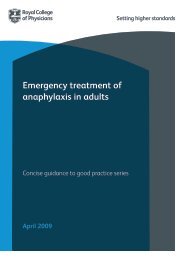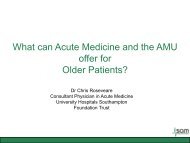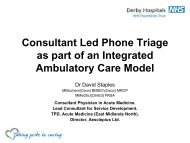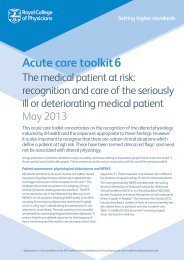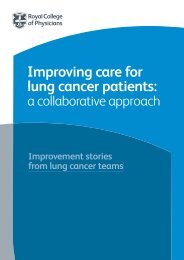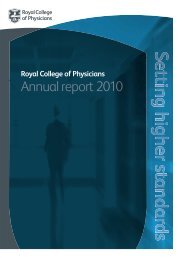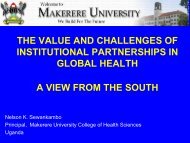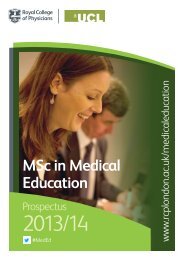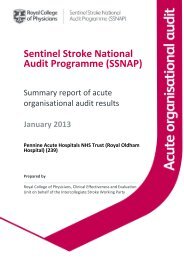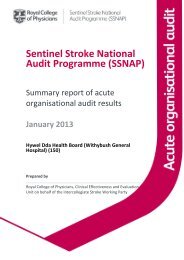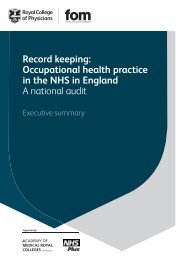Consultant physicians working with patients 5th edition - FSEM
Consultant physicians working with patients 5th edition - FSEM
Consultant physicians working with patients 5th edition - FSEM
You also want an ePaper? Increase the reach of your titles
YUMPU automatically turns print PDFs into web optimized ePapers that Google loves.
<strong>Consultant</strong> <strong>physicians</strong> <strong>working</strong> <strong>with</strong> <strong>patients</strong><br />
British Tinnitus Association (BTA), British Deaf<br />
Association (BDA), Royal Association for the Deaf<br />
(RAD), SignHealth (the National Society for Mental<br />
Health and Deafness; previously called Sign),<br />
Council for the Advancement of Communication<br />
<strong>with</strong> Deaf People (CACDP), Usher’s Society, Sense<br />
and Afasic) should be readily available in outpatient<br />
departments.<br />
� It is good practice to copy <strong>patients</strong> and parents into<br />
clinical correspondence to ensure that they are aware<br />
ofthecareplanandareinformedaboutresultsof<br />
investigations.<br />
� Some services already use adult role models, local<br />
self-help groups or patient volunteers as expert<br />
<strong>patients</strong>.<br />
AVPs are trained to be highly effective communicators.<br />
Relevant professional interpreters must be available for<br />
both the family and the patient during medical<br />
consultations, recognising that communication needs<br />
may be different, eg a BSL interpreter for the patient<br />
and a mother-tongue interpreter for parents/carers for<br />
medical consultations.<br />
4 Interspecialty and interdisciplinary liaison<br />
Multidisciplinary team <strong>working</strong><br />
Both adult and paediatric AVM services are delivered by<br />
MDTs that include other health professionals, education<br />
and social services. MDTs may include community<br />
paediatricians, audiologists, specialist nurses, speech<br />
and language therapists, hearing therapists, teachers of<br />
the deaf, psychologists, behavioural therapists,<br />
educational audiologists, physiotherapists, social<br />
workers and occupational therapists. Each has a specific<br />
but overlapping role to play and successful teamwork is<br />
based on mutual recognition and respect.<br />
The patient and their family are an integral part of this<br />
team.<br />
Working <strong>with</strong> other specialties<br />
Closely linked specialties include otology, neurology<br />
and neurosurgery, paediatrics and child health (<strong>working</strong><br />
both in the community and in acute paediatrics and<br />
neonatology), clinical genetics, radiology, immunology<br />
and allergy, old age medicine and ophthalmology. There<br />
will be a number of <strong>patients</strong> who are common to these<br />
groups, where diagnosis or care is shared depending on<br />
the patient’s symptoms at any one time.<br />
38<br />
The wide-ranging prevalence of audiovestibular<br />
symptoms in other conditions means that AVPs will<br />
be in contact <strong>with</strong> or receiving referrals from many<br />
different disciplines.<br />
Working <strong>with</strong> GPs and GPwSIs<br />
Some GPwSIs in otolaryngology are concerned <strong>with</strong><br />
aural care and simple audiovestibular disorders in<br />
adults and this area could be usefully expanded.<br />
Other specialty activity beyond local services<br />
Multiagency <strong>working</strong> is fundamental to AVM.<br />
Education services share the care of children <strong>with</strong><br />
permanent childhood hearing impairment while social<br />
services and job centres are important in terms of both<br />
employment for adults and appropriate domestic<br />
support for children and adults.<br />
5 Delivering a high-quality service<br />
What is a high-quality service?<br />
AVPs are medically trained professionals <strong>with</strong> the<br />
highest level of skills and competencies in the field and<br />
deliver effective and efficient assessment, diagnosis and<br />
management of disorders through an MDT in as few<br />
visits as possible.<br />
The British Association of Audiological Physicians<br />
(BAAP) policy document 2002 13 contains<br />
recommendations for the staff and details of the<br />
equipment (less than five years old) required for a<br />
population of 500,000 <strong>patients</strong> (Tables 1 and 2). It<br />
covers paediatric and adult vestibular and hearing<br />
services in both community and hospital sites. It also<br />
refers to the staff required for a team based at a main<br />
unit <strong>working</strong> across several sites. Since it was published,<br />
interdisciplinary standards for specific activities have<br />
been implemented, eg NHSP 14 and Modernising<br />
Children’s Hearing Aid Services (MCHAS). 15<br />
Maintaining and improving the quality of care<br />
Maintenance and improvement of service quality is<br />
ensured by clinical governance, which includes:<br />
� development of patient-care pathways, systems and<br />
processes to improve the efficiency of patient flow<br />
� appraisal and peer-review system<br />
� revalidation<br />
C○ Royal College of Physicians 2011



